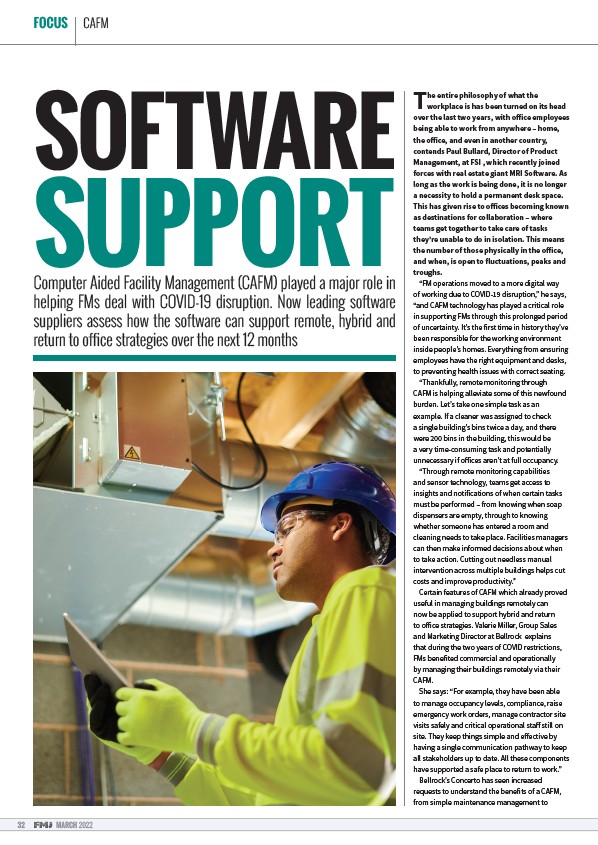
FOCUS CAFM
SOFTWARE
SUPPORT
Computer Aided Facility Management (CAFM) played a major role in
helping FMs deal with COVID-19 disruption. Now leading software
suppliers assess how the software can support remote, hybrid and
return to oƝ ce strategies over the next 12 months
32 MARCH 2022
The entire philosophy of what the
workplace is has been turned on its head
over the last two years, with o ice employees
being able to work from anywhere – home,
the o ice, and even in another country,
contends Paul Bullard, Director of Product
Management, at FSI , which recently joined
forces with real estate giant MRI SoŠ ware. As
long as the work is being done, it is no longer
a necessity to hold a permanent desk space.
This has given rise to o ices becoming known
as destinations for collaboration – where
teams get together to take care of tasks
they’re unable to do in isolation. This means
the number of those physically in the o ice,
and when, is open to fluctuations, peaks and
troughs.
“FM operations moved to a more digital way
of working due to COVID-19 disruption,” he says,
“and CAFM technology has played a critical role
in supporting FMs through this prolonged period
of uncertainty. It’s the first time in history they’ve
been responsible for the working environment
inside people’s homes. Everything from ensuring
employees have the right equipment and desks,
to preventing health issues with correct seating.
“Thankfully, remote monitoring through
CAFM is helping alleviate some of this newfound
burden. Let’s take one simple task as an
example. If a cleaner was assigned to check
a single building’s bins twice a day, and there
were 200 bins in the building, this would be
a very time-consuming task and potentially
unnecessary if oœ ices aren’t at full occupancy.
“Through remote monitoring capabilities
and sensor technology, teams get access to
insights and notifications of when certain tasks
must be performed – from knowing when soap
dispensers are empty, through to knowing
whether someone has entered a room and
cleaning needs to take place. Facilities managers
can then make informed decisions about when
to take action. Cutting out needless manual
intervention across multiple buildings helps cut
costs and improve productivity.”
Certain features of CAFM which already proved
useful in managing buildings remotely can
now be applied to support hybrid and return
to oœ ice strategies. Valerie Miller, Group Sales
and Marketing Director at Bellrock explains
that during the two years of COVID restrictions,
FMs benefited commercial and operationally
by managing their buildings remotely via their
CAFM.
She says: “For example, they have been able
to manage occupancy levels, compliance, raise
emergency work orders, manage contractor site
visits safely and critical operational staœ still on
site. They keep things simple and eœ ective by
having a single communication pathway to keep
all stakeholders up to date. All these components
have supported a safe place to return to work.”
Bellrock’s Concerto has seen increased
requests to understand the benefits of a CAFM,
from simple maintenance management to